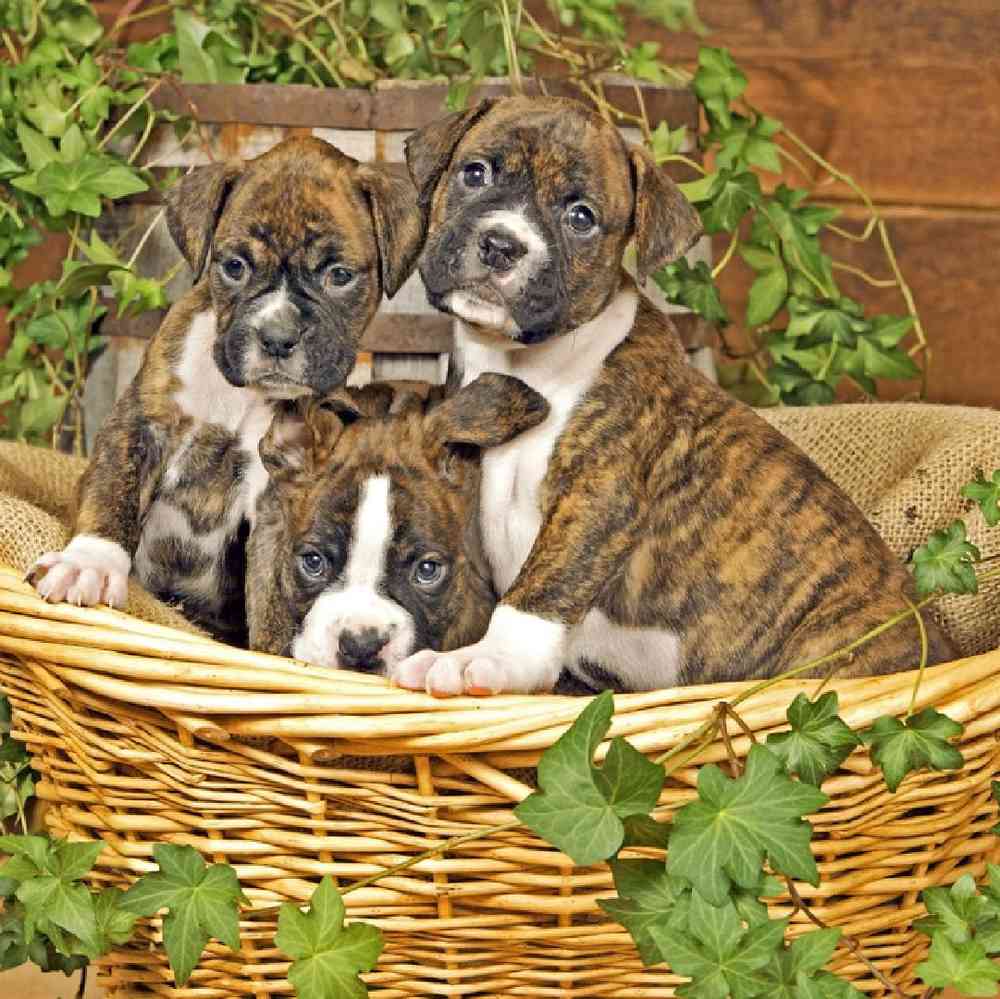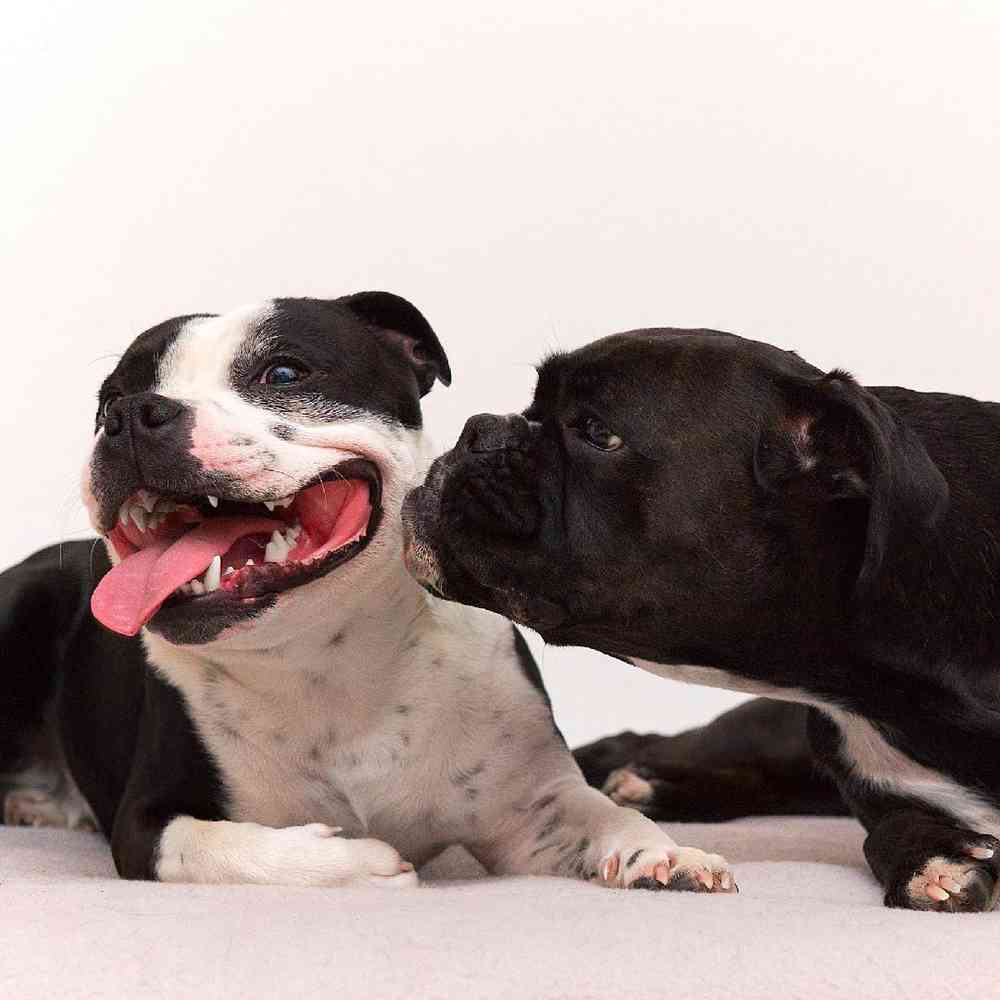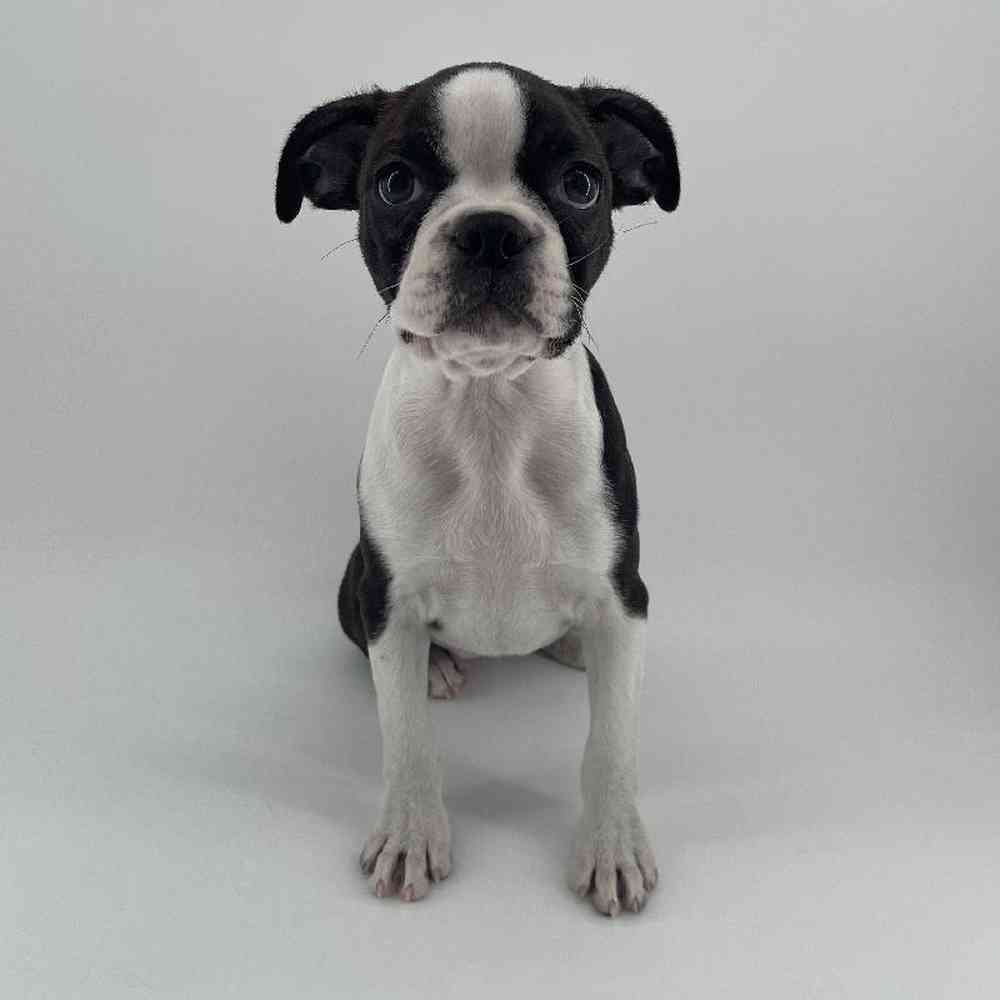

AKC Registrable
Family Dog
Guard Dog
Boxer
Loyalty, affection, intelligence, work ethic, and good looks: Boxers are the whole doggy package. Bright and alert, sometimes silly, but always courageous, the Boxer has been among America’s most popular dog breeds for a very long time.
Available Pets
All our Pets have found their homes. Please enter your contact information below so we can get in touch with you when we have found the perfect Pets for your family.
Breed Info
Health Awareness
The Boxer has a life expectancy of 11-14 years and is prone to bloat, cancer, tumors, progressive retinal atrophy, cardiomyopathy, epilepsy, allergies, arthritis, hip dysplasia, knee and back problems and excessive flatulence.
Personality
The Boxer is known for being gentle and patient with children, however no child should be allowed to abuse your Boxer by climbing all over him or her, pulling ears and tails, grabbing toys from the dog, etc. All children need to be respectful of all dogs. However, your Boxer is highly affectionate and loyal, playful and happy. They are exuberant and energetic, known for using their paws as if sparring, so you will need to be careful of their unintentional actions when playing with children. They love to jump and you will need to teach your Boxer how to stop that natural behavior. Great both as watchdogs and guard dogs, they are wary of strangers but very friendly with those people who are familiar. You will need to be a consistent and committed leader using humane communication and training techniques. Your Boxer will want to bond with you and using humane techniques will make your relationship stronger and most successful.
Exercise/Energy Level
The Boxer is an athlete. This breed needs daily exercise such as a brisk walk, run or jog in addition to off leash play in a safe area.
Additional Information
Grooming Requirements: Requires regular brushing and bathing. Coat: Short and smooth Shedding: Average shedding Hypoallergenic: No Apartment Living: Good for apartment living if they are exercised daily Lap Dog: No Good With Children: Good with all children Good With Other Pets: Good with most other pets when well socialized at an early age, but should not be left alone with small non-canine pets. This breed can also be prone to aggression toward other dogs.
Breed Standard
General Appearance
General Appearance: The ideal Boxer is a medium-sized, square-built dog of good substance with short back, strong limbs, and short, tight-fitting coat. His well-developed muscles are clean, hard, and appear smooth under taut skin. His movements denote energy. The gait is firm yet elastic, the stride free and ground-covering, the carriage proud. Developed to serve as guard, working, and companion dog, he combines strength and agility with elegance and style. His expression is alert and his temperament steadfast and tractable. The chiseled head imparts to the Boxer a unique individual stamp. It must be in correct proportion to the body. The broad, blunt muzzle is the distinctive feature, and great value is placed upon its being of proper form and balance with the skull. In judging the Boxer first consideration is given to general appearance and overall balance. Special attention is then devoted to the head, after which the individual body components are examined for their correct construction, and the gait evaluated for efficiency.
Size, Proportion, Substance
Adult males 23 to 25 inches; females 21½ to 23½ inches at the withers. Proper balance and quality in the individual should be of primary importance since there is no size disqualification. Proportion - The body in profile is square in that a horizontal line from the front of the forechest to the rear projection of the upper thigh should equal the length of a vertical line dropped from the top of the withers to the ground. Substance – Sturdy, with balanced musculature. Males larger boned than females.
Head
The beauty of the head depends upon the harmonious proportion of muzzle to skull. The blunt muzzle is ⅓ the length of the head from the occiput to the tip of the nose, and ⅔ the width of the skull. The head should be clean, not showing deep wrinkles (wet). Wrinkles typically appear upon the forehead when ears are erect, and are always present from the lower edge of the stop running downward on both sides of the muzzle. Expression - Intelligent and alert. Eyes - Dark brown in color, frontally placed, generous, not too small, too protruding, or too deep set. Their mood-mirroring character, combined with the wrinkling of the forehead, gives the Boxer head its unique quality of expressiveness. Third eyelids preferably have pigmented rims. Ears - Set at the highest points of the sides of the skull, the ears are customarily cropped, cut rather long and tapering, and raised when alert. If uncropped, the ears should be of moderate size, thin, lying flat and close to the cheeks in repose, but falling forward with a definite crease when alert. Skull - The top of the skull is slightly arched, not rounded, flat, nor noticeably broad, with the occiput not overly pronounced. The forehead shows a slight indentation between the eyes and forms a distinct stop with the topline of the muzzle. The cheeks should be relatively flat and not bulge (cheekiness), maintaining the clean lines of the skull as they taper into the muzzle in a slight, graceful curve. Muzzle and Nose - The muzzle, proportionately developed in length, width, and depth, has a shape influenced first through the formation of both jawbones, second through the placement of the teeth, and third through the texture of the lips. The top of the muzzle should not slant down (downfaced), nor should it be concave (dishfaced); however, the tip of the nose should lie slightly higher than the root of the muzzle. The nose should be broad and black. Bite and Jaw Structure - The Boxer bite is undershot, the lower jaw protruding beyond the upper and curving slightly upward. The incisor teeth of the lower jaw are in a straight line, with the canines preferably up front in the same line to give the jaw the greatest possible width. The upper line of the incisors is slightly convex with the corner upper incisors fitting snugly in back of the lower canine teeth on each side. Neither the teeth nor the tongue should ever show when the mouth is closed. The upper jaw is broad where attached to the skull and maintains this breadth, except for a very slight tapering to the front. The lips, which complete the formation of the muzzle, should meet evenly in front. The upper lip is thick and padded, filling out the frontal space created by the projection of the lower jaw, and laterally is supported by the canines of the lower jaw. Therefore, these canines must stand far apart and be of good length so that the front surface of the muzzle is broad and squarish and, when viewed from the side, shows moderate layback. The chin should be perceptible from the side as well as from the front. Any suggestion of an overlip obscuring the chin should be penalized.
Neck, Topline, Body
Neck - Round, of ample length, muscular and clean without excessive hanging skin (dewlap). The neck should have a distinctly arched and elegant nape blending smoothly into the withers. Back and Topline: The back is short, straight, muscular, firm, and smooth. The topline is slightly sloping when the Boxer is at attention, leveling out when in motion. Body - The chest is of fair width, and the forechest well-defined and visible from the side. The brisket is deep, reaching down to the elbows; the depth of the body at the lowest point of the brisket equals half the height of the dog at the withers. The ribs, extending far to the rear, are well-arched but not barrel-shaped. The loins are short and muscular. The lower stomach line is slightly tucked up, blending into a graceful curve to the rear. The croup is slightly sloped, flat and broad. The pelvis is long, and in females especially broad. The tail is set high, docked, and carried upward. An undocked tail should be severely penalized.
Hindquarters
The hindquarters are strongly muscled, with angulation in balance with that of the forequarters. The thighs are broad and curved, the breech musculature hard and strongly developed. Upper and lower thigh are long. The legs are well-angulated at the stifle, neither too steep nor over-angulated, with clearly defined, well "let down" hock joints. Viewed from behind, the hind legs should be straight, with hock joints leaning neither in nor out. From the side, the leg below the hock (metatarsus) should be almost perpendicular to the ground, with a slight slope to the rear permissible. The metatarsus should be short, clean, and strong. The Boxer has no rear dewclaws.
Coat
Short, shiny, lying smooth and tight to the body.
Gait
Viewed from the side, proper front and rear angulation is manifested in a smoothly efficient, level-backed, ground covering stride with a powerful drive emanating from a freely operating rear. Although the front legs do not contribute impelling power, adequate reach should be evident to prevent interference, overlap, or sidewinding (crabbing). Viewed from the front, the shoulders should remain trim and the elbows not flare out. The legs are parallel until gaiting narrows the track in proportion to increasing speed, then the legs come in under the body but should never cross. The line from the shoulder down through the leg should remain straight although not necessarily perpendicular to the ground. Viewed from the rear, a Boxer's rump should not roll. The hind feet should dig in and track relatively true with the front. Again, as speed increases, the normally broad rear track will become narrower. The Boxer's gait should always appear smooth and powerful, never stilted or inefficient.
Temperament
Bright, Fun-Loving, Active
Disqualifications
Boxers that are any color other than fawn or brindle. Boxers with a total of white markings exceeding one-third of the entire coat. The foregoing description is that of the ideal Boxer. Any deviation from the above described dog must be penalized to the extent of the deviation.
Color
The colors are fawn and brindle. Fawn shades vary from light tan to mahogany. The brindle ranges from sparse but clearly defined black stripes on a fawn background to such a heavy concentration of black striping that the essential fawn background color barely, although clearly, shows through (which may create the appearance of reverse brindling). White markings, if present, should be of such distribution as to enhance the dog's appearance, but may not exceed one-third of the entire coat. They are not desirable on the flanks or on the back of the torso proper. On the face, white may replace part of the otherwise essential black mask, and may extend in an upward path between the eyes, but it must not be excessive, so as to detract from true Boxer expression. The absence of white markings, the so-called "plain" fawn or brindle, is perfectly acceptable, and should not be penalized in any consideration of color. Disqualifications Boxers that are any color other than fawn or brindle. Boxers with a total of white markings exceeding one-third of the entire coat.
Overview
Group
Working
About
A well-made Boxer in peak condition is an awesome sight. A male can stand as high as 25 inches at the shoulder; females run smaller. Their muscles ripple beneath a short, tight-fitting coat. The dark brown eyes and wrinkled forehead give the face an alert, curious look. The coat can be fawn or brindle, with white markings. Boxers move like the athletes they are named for: smooth and graceful, with a powerful forward thrust. Boxers are upbeat and playful. Their patience and protective nature have earned them a reputation as a great dog with children. They take the jobs of watchdog and family guardian seriously and will meet threats fearlessly. Boxers do best when exposed to a lot of people and other animals in early puppyhood.
History
The Boxer’s ancestors, the war dogs of the Assyrian empire, go back as far as 2,500 B.C. But what we think of today as a Boxer can be traced to Germany of the late 1800s and early 20th century. The breed is thought to have been bred down by German dog fanciers from a larger, heavier German breed called the Bullenbeisser (“bull biter”). In medieval times the Bullenbeisser was Germany’s premier big-game hunter, used by noblemen to run down, catch, and hold such formidable opponents as bear, bison, and wild boar on vast ducal estates. By the early 1800s, the political situation in the German states was changing. German nobles were out of favor. Their estates were broken up, and the cherished tradition of lavishly appointed boar hunts came to an end. By 1865, the mighty Bullenbeisser was out of a job. Through judicious crosses to a smaller, mastiff-type breed from England, the obsolete big-game hunter gained a new lease on life. By the late 1800s, the modern Boxer—a sleeker, more elegant dog—had come into focus. (The English name Boxer refers to the way the breed spars, like a prizefighter, with their front paws when playing or defending themselves.) Over the years, Boxers have done many jobs: athlete, cattle dog, police dog, war dog (in both world wars), watchdog, protection dog, and guide dog for the blind. The AKC registered its first Boxer in 1904, but the breed’s U.S. heyday began in the 1950s, when a Westminster-winning Boxer named Bang Away became a national celebrity. Since that time, Boxers have reigned as one of America’s top 10 most popular breeds.
Standard
The ideal Boxer is a medium-sized, square-built dog of good substance with short back, strong limbs, and short, tight-fitting coat. His well-developed muscles are clean, hard, and appear smooth under taut skin. His movements denote energy. The gait is firm yet elastic, the stride free and ground-covering, the carriage proud. Developed to serve as guard, working, and companion dog, he combines strength and agility with elegance and style. His expression is alert and his temperament steadfast and tractable. The chiseled head imparts to the Boxer a unique individual stamp. It must be in correct proportion to the body. The broad, blunt muzzle is the distinctive feature, and great value is placed upon its being of proper form and balance with the skull.
Nutrition
The Boxer should do well on a high-quality dog food, whether commercially manufactured or home-prepared with your veterinarian’s supervision and approval. Any diet should be appropriate to the dog’s age (puppy, adult, or senior). Some dogs are prone to getting overweight, so watch your dog’s calorie consumption and weight level. Treats can be an important aid in training, but giving too many can cause obesity. Learn about which human foods are safe for dogs, and which are not. Check with your vet if you have any concerns about your dog’s weight or diet. Clean, fresh water should be available at all times.
Grooming
The Boxer’s short, shiny coat requires very little grooming. A good once-over with a rubber curry-brush or a hound glove once or twice a week should keep him looking his best. The Boxer tends to be a clean dog, needing a bath only occasionally. His nails should be trimmed at least once a month unless naturally worn down on a hard surface, and to prevent tartar buildup his teeth should be brushed often—daily if possible.
Exercise
Boxers are very playful, high-energy dogs. They need ample exercise every day, on leash or in a securely fenced area. The Boxer must never be allowed to run loose. The breed’s heritage as a chaser of wild game means that they spend a good deal of time jumping and leaping about—as young dogs, they are constantly in need of reminders to teach them to stay “down.” Because the Boxer is a powerful, active, and playful dog, he may not be the best choice for a very frail adult, nor for a small child who could be overwhelmed by a well-meaning but bouncy puppy.
Training
Early socialization and puppy training classes are vital in channeling the breed’s energy and exuberance in a positive way. Boxers are highly intelligent, but can become bored with repetition. They tend to have a mind of their own and are excellent problem solvers. Not always tolerant of other dogs of the same sex, most Boxers of opposite sexes enjoy each other’s company. Boxers excel in a wide range of canine sports, including obedience, agility, and herding, and they perform brilliantly as service, assistance, and therapy dogs, and in roles such as drug detection and search-and-rescue.
Health
The Boxer does not have a high tolerance for either extreme heat or cold, and he should always be kept inside the house as a beloved member of the family. Responsible breeders screen their stock for health conditions such as hip dysplasia, heart conditions such as aortic stenosis and cardiomyopathy, thyroid deficiency, degenerative myelopathy, and certain cancers. The website of the breed’s national parent club, the American Boxer Club, provides in-depth details about the breed’s health and care.
Trivia
Did you know?
A Boxer plays Hank in CSI. There are two types of Boxers: the American Boxer and the German Boxer. The German Boxer has a more muscular body and a larger head than the American Boxer.







